
The 1948 United States presidential election was the 41st quadrennial presidential election. It was held on Tuesday, November 2, 1948. Incumbent President Harry S. Truman, the Democratic nominee, defeated Republican Governor Thomas E. Dewey. Truman's victory is considered to be one of the greatest election upsets in American history.

The 1952 United States presidential election was the 42nd quadrennial presidential election. It was held on Tuesday, November 4, 1952. Republican Dwight D. Eisenhower won a landslide victory over Democrat Adlai Stevenson, ending a string of Democratic Party wins that stretched back to 1932.

The 1948 Republican National Convention was held at the Municipal Auditorium, in Philadelphia, Pennsylvania, from June 21 to 25, 1948.
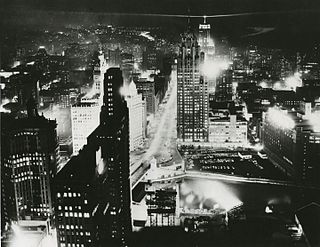
The 1956 Democratic National Convention nominated former Governor Adlai Stevenson of Illinois for President and Senator Estes Kefauver of Tennessee for Vice President. It was held in the International Amphitheatre on the South Side of Chicago, Illinois August 13–August 17, 1956. Unsuccessful candidates for the presidential nomination included Governor W. Averell Harriman of New York, Senator Lyndon B. Johnson of Texas, and Senator Stuart Symington of Missouri.
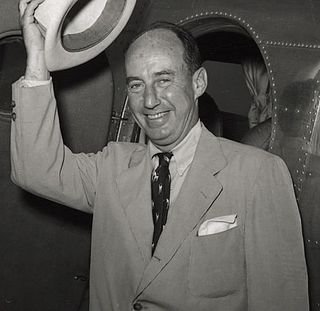
The 1952 Democratic National Convention was held at the International Amphitheatre in Chicago, Illinois from July 21 to July 26, 1952, which was the same arena the Republicans had gathered in a few weeks earlier for their national convention from July 7 to July 11, 1952. Four major candidates sought the nomination: U.S. Senator Estes Kefauver of Tennessee, Governor Adlai E. Stevenson, II, of Illinois, Senator Richard Russell of Georgia and Averell Harriman of New York.
The Draft Eisenhower movement was the only successful political draft of the 20th century to take a private citizen to the Oval Office. It was a widespread American grassroots political movement that eventually persuaded Dwight D. Eisenhower to run for President. The movement culminated in the 1952 presidential election in which Eisenhower won the Republican nomination and defeated Democrat Adlai Stevenson to become the 34th President of the United States.
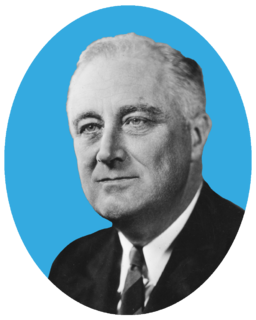
The 1940 Democratic National Convention was held at the Chicago Stadium in Chicago, Illinois from July 15 to July 18, 1940. The convention resulted in the nomination of President Franklin D. Roosevelt for an unprecedented third term. Secretary of Agriculture Henry A. Wallace from Iowa was nominated for Vice President.

The 1944 Democratic National Convention was held at the Chicago Stadium in Chicago, Illinois from July 19 to July 21, 1944. The convention resulted in the nomination of President Franklin D. Roosevelt for an unprecedented fourth term. Senator Harry S. Truman of Missouri was nominated for Vice President. Including Roosevelt's nomination for the vice-presidency in 1920, it was the fifth time Roosevelt had been nominated on a national ticket. The keynote address was given by Governor Robert S. Kerr of Oklahoma, in which he "gave tribute to Roosevelt's war leadership and new deal policies."
The 1928 Democratic National Convention was held at Sam Houston Hall in Houston, Texas, June 26–28, 1928. The convention resulted in the nomination of Governor Alfred E. Smith of New York for President and Senator Joseph T. Robinson of Arkansas for Vice President.
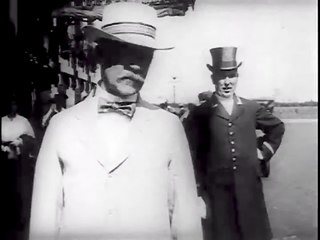
The 1916 Republican National Convention was held in Chicago from June 7 to June 10. A major goal of the party's bosses at the convention was to heal the bitter split within the party that had occurred in the 1912 presidential campaign. In that year, Theodore Roosevelt bolted the GOP and formed his own political party, the Progressive Party, which contained most of the GOP's liberals. William Howard Taft, the incumbent president, won the nomination of the regular Republican Party. This split in the GOP ranks divided the Republican vote and led to the election of Democrat Woodrow Wilson. Although several candidates were openly competing for the 1916 nomination—most prominently conservative Senator Elihu Root of New York, Senator John W. Weeks of Massachusetts, and liberal Senator Albert Cummins of Iowa—the party's bosses wanted a moderate who would be acceptable to all factions of the party. They turned to Supreme Court Justice Charles Evans Hughes, who had served on the court since 1910 and thus had the advantage of not having publicly spoken about political issues in six years. Although he had not sought the nomination, Hughes made it known that he would not turn it down; he won the nomination on the third ballot. Former Vice-President Charles W. Fairbanks was nominated as his running mate. Hughes was the only Supreme Court Justice to be nominated for president by a major political party. Fairbanks was the last former vice president, to be nominated for vice president.
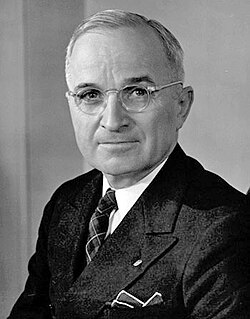
Electoral history of Harry S. Truman, 33rd President of the United States (1945–1953), 34th Vice President of the United States (1945) and United States Senator from Missouri (1935–1945)

The Democratic Party's 1944 nomination for Vice President of the United States was determined at the 1944 Democratic National Convention, on July 21, 1944. U.S. Senator Harry S. Truman from Missouri was nominated to be President Franklin D. Roosevelt's running-mate in his bid to be re-elected for a fourth term.

The 1948 United States presidential election in New Hampshire took place on November 2, 1948, as part of the 1948 United States presidential election, which was held throughout all contemporary 48 states. Voters chose four representatives, or electors to the Electoral College, who voted for president and vice president.

This article lists those who were potential candidates for the Democratic nomination for Vice President of the United States in the 1964 election. After the assassination of Democratic President John F. Kennedy in 1963, Vice President Lyndon B. Johnson ascended to the presidency. As the 25th Amendment had not yet been passed, there was no process for filling the office of vice president until the next election, and Speaker of the House John William McCormack was next-in-line for the presidency from November 1963 to January 1965. Johnson carefully considered his running mate for the 1964 election, and put up "trial balloons" in the media about possible running mates. Among those speculated at the time were Connecticut Senators Abraham Ribicoff and Thomas J. Dodd, Secretary of Defense Robert McNamara, New York Mayor Robert Wagner, California Governor Pat Brown, and Minnesota Senators Hubert Humphrey and Eugene McCarthy. Many Democrats also hoped for Attorney General Robert F. Kennedy, the brother of former President John F. Kennedy, but Johnson carefully maneuvered to keep Kennedy off the ticket due to personal enmity between the two. After an interview in the Oval Office, Johnson announced his choice of Humphrey, who provided geographic balance to the ticket and had been a key lieutenant for Johnson in the Senate, particularly in regards to the 1964 Civil Rights Act. Humphrey then easily won the vice presidential nomination on the first ballot at the 1964 Democratic National Convention. The Johnson-Humphrey ticket went on to beat the Goldwater-Miller ticket in the 1964 election. Humphrey later won the 1968 Democratic presidential nomination over McCarthy, but lost the election to Richard Nixon.
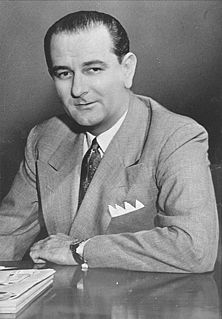
This article lists those who were potential candidates for the Democratic nomination for Vice President of the United States in the 1960 election. After winning the presidential nomination on the first ballot of the 1960 Democratic National Convention, Massachusetts Senator John F. Kennedy turned his attention to picking a running mate. Kennedy chose Senate Majority Leader Lyndon B. Johnson, who had finished second on the presidential ballot, as his running mate. Johnson, a Protestant Texan, provided geographical and religious balance to a ticket led by a Catholic Northeasterner, but many liberals did not like the pick. Many were surprised both that Kennedy made the offer and that Johnson accepted the offer, as the two had been rivals for the 1960 presidential nomination. According to some accounts, Kennedy had offered the position to Johnson as a courtesy and expected Johnson to decline the offer; when Johnson accepted, Kennedy sent his brother, Robert F. Kennedy, to talk Johnson out of accepting the offer. However, Kennedy may have made the offer in earnest due to Johnson's appeal in the south, Johnson's friendly relationship with Speaker of the House Sam Rayburn, and Kennedy's desire to remove Johnson as Senate Majority Leader in favor of the more liberal Mike Mansfield. Regardless, Johnson decided that accepting the offer would be better for his political career and better position himself to become president, and so he chose to become Kennedy's running mate. The Democratic convention confirmed Johnson as the vice presidential nominee, although the delegation from Washington, D.C. attempted to select Minnesota Governor Orville Freeman instead.
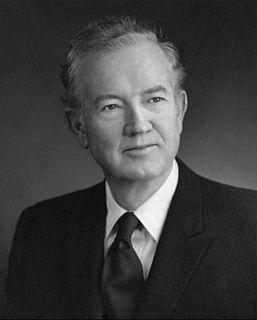
This article lists those who were potential candidates for the Democratic nomination for Vice President of the United States in the 1952 election. After winning the presidential nomination on the third ballot of the 1952 Democratic National Convention, Illinois Governor Adlai Stevenson consulted with Democratic Party leaders such as President Harry S. Truman and Speaker Sam Rayburn. Stevenson chose Alabama Senator John Sparkman, a Southern centrist, as his running mate. Sparkman won the vice presidential nomination on the first ballot as no serious rival tried to displace Stevenson's choice. However, many Northerners were not enthused with the choice of Sparkman due to Sparkman's stance on civil rights. During the 1952 convention, Sparkman, who had supported Senator Richard Russell for president, played a part in watering down the party's platform on civil rights. New York Representative Adam Clayton Powell Jr. and others walked out of the convention after the choice of Sparkman was announced. The Democratic ticket lost the 1952 election to the Republican ticket of Dwight D. Eisenhower and Richard Nixon.
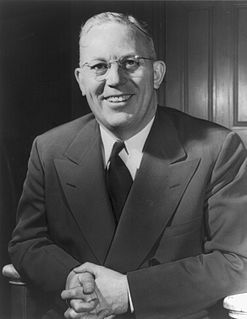
This article lists those who were potential candidates for the Republican nomination for Vice President of the United States in the 1948 election. After New York Governor Thomas Dewey secured the Republican presidential nomination on the third ballot of the 1948 Republican National Convention, the convention needed to choose Dewey's running mate. Dewey and several party leaders discussed Dewey's running mate during the evening of June 24. House Majority Leader Charles A. Halleck and former Minnesota Governor Harold Stassen were both considered, but Dewey ultimately decided to ask California Governor Earl Warren to serve as his running mate. Warren had earlier said that he would not accept the position, and asked for time to consider the offer. In the meantime, Stassen was asked to serve as running mate if Warren declined. However, Dewey convinced the reluctant Warren to join his ticket. Halleck alleged that he had been promised the vice presidency in exchange for supporting Dewey, but Halleck's isolationism convinced Dewey and others to pass him over. The Dewey-Warren ticket was well-received by the press, as it combined the youthful, popular governors of two of the three most populous states in the nation. Despite being favored by most, the Dewey-Warren ticket lost the 1948 election to the Democratic Harry S. Truman-Alben W. Barkley ticket. In 1953, Warren was appointed Chief Justice of the United States by President Dwight D. Eisenhower.





















